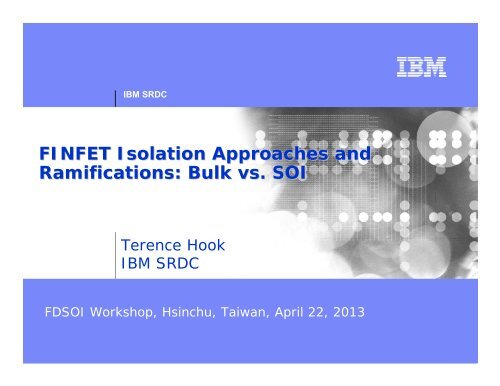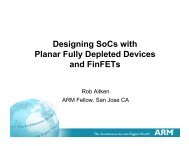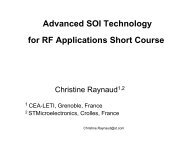FINFET Isolation Approaches and Ramifications - SOI Industry ...
FINFET Isolation Approaches and Ramifications - SOI Industry ...
FINFET Isolation Approaches and Ramifications - SOI Industry ...
Create successful ePaper yourself
Turn your PDF publications into a flip-book with our unique Google optimized e-Paper software.
IBM SRDC<br />
<strong>FINFET</strong> <strong>Isolation</strong> <strong>Approaches</strong> <strong>and</strong><br />
<strong>Ramifications</strong>: Bulk vs. <strong>SOI</strong><br />
Terence Hook<br />
IBM SRDC<br />
FD<strong>SOI</strong> Workshop, Hsinchu, Taiwan, April 22, 2013
IBM Semiconductor Research <strong>and</strong> Development Center<br />
Background – FD<strong>SOI</strong> <strong>and</strong> FinFETs<br />
• Fully Depleted Transistors: FD<strong>SOI</strong> <strong>and</strong> FinFETs<br />
– Similarities<br />
Electrostatics<br />
Access resistance<br />
Threshold fluctuations<br />
– Differences<br />
Physical Orientation<br />
Density <strong>and</strong> “fin effect”<br />
Backgate <strong>and</strong> body effect<br />
• FinFETs on <strong>SOI</strong> <strong>and</strong> bulk substrates<br />
– Process Comparison<br />
– Fin Taper<br />
– <strong>Isolation</strong> doping<br />
Intrawell<br />
Interwell<br />
Drain-source current<br />
– Self-heating <strong>and</strong> history effect<br />
– Transistor mismatch<br />
– Work function <strong>and</strong> gate reliability<br />
– Process variations<br />
• Conclusion<br />
FD<strong>SOI</strong> Workshop Hsinchu, Taiwan April 22, 2013
IBM Semiconductor Research <strong>and</strong> Development Center<br />
FD<strong>SOI</strong> <strong>and</strong> FinFET transistors<br />
• The key in both device types is very thin silicon.<br />
– FD<strong>SOI</strong> is 5-8nm thick<br />
– FinFET 8-15nm wide<br />
– The short-channel effect is set by physical geometry, not doping<br />
• Both are challenged in getting the current out of the thin body <strong>and</strong><br />
into the contact metal.<br />
• In principle both FinFET <strong>and</strong> FD<strong>SOI</strong> bodies can be undoped<br />
– The threshold voltage is set by the gate work function<br />
– Doping can be used to adjust threshold voltage but there are adverse<br />
implications<br />
– FinFETs built in bulk silicon inherently require some level of doping<br />
• While electrical characteristics share some similarities, the structures<br />
<strong>and</strong> processes are completely different<br />
FD<strong>SOI</strong> Workshop Hsinchu, Taiwan April 22, 2013
IBM Semiconductor Research <strong>and</strong> Development Center<br />
Electrostatics<br />
“Conventional”<br />
FD<strong>SOI</strong><br />
FinFET<br />
Λ<br />
S<br />
Gate<br />
D<br />
Λ/2<br />
S<br />
Gate<br />
BOX<br />
Substrate<br />
D<br />
S<br />
Gate<br />
Gate<br />
D<br />
Λ<br />
Λ = t dep +ε si /ε ox t ox<br />
L ~ 1/√N<br />
• Confinement of field<br />
lines by doping<br />
Λ = 2(t si +ε si /ε ox t ox )<br />
L min ~ 3t si +9t ox<br />
• Confinement of field<br />
lines by BOX<br />
Λ = t si +ε si /ε ox 2t ox<br />
L min ~ 1.5t si +9t ox<br />
• Confinement of field<br />
lines by gates<br />
2004 IEEE <strong>SOI</strong> Short Course<br />
Huang & Nowak<br />
D. Frank, et al.<br />
FD<strong>SOI</strong> Workshop Hsinchu, Taiwan April 22, 2013
IBM Semiconductor Research <strong>and</strong> Development Center<br />
Access resistance<br />
FD<strong>SOI</strong><br />
Finfet<br />
Thin-body devices use epitaxial silicon deposition on the<br />
source <strong>and</strong> drain to dope <strong>and</strong> “fatten” the body for the<br />
contact<br />
FD<strong>SOI</strong> Workshop Hsinchu, Taiwan April 22, 2013
IBM Semiconductor Research <strong>and</strong> Development Center<br />
Matching<br />
• Matching is affected by<br />
several components:<br />
– Physical variations<br />
such as line-edgeroughness<br />
– Electrical variations<br />
such as metal-gate<br />
work function<br />
variations<br />
– Doping variations<br />
subject to classic<br />
Poisson statistical<br />
variations<br />
• Undoped FinFET <strong>and</strong><br />
FD<strong>SOI</strong> are comparable<br />
calculted σΔVt (mV)<br />
40<br />
30<br />
20<br />
10<br />
IEDM 2011<br />
1.3mV-um<br />
AVT<br />
0<br />
0.00 0.01 0.02 0.03<br />
1/sqrt(LxW) (nm -1 )<br />
VLSI 2011<br />
1.5mV-um<br />
• Adding doping degrades<br />
matching<br />
FD<strong>SOI</strong><br />
FinFET<br />
FD<strong>SOI</strong> Workshop Hsinchu, Taiwan April 22, 2013
IBM Semiconductor Research <strong>and</strong> Development Center<br />
PD<strong>SOI</strong> FD<strong>SOI</strong> FinFET orientation<br />
Gate<br />
Drain<br />
Gate<br />
Drain<br />
Drain<br />
Current flow<br />
Source<br />
Current flow<br />
Source<br />
Source<br />
Source<br />
Fin<br />
Gate<br />
Source<br />
Current<br />
flow<br />
PD<strong>SOI</strong><br />
FD<strong>SOI</strong><br />
FinFET<br />
Electron Mobility (cm 2 V -1 s -1 )<br />
500<br />
400<br />
Universal (100) curve<br />
300<br />
200<br />
100<br />
0<br />
0 5 10 15<br />
N inv (X10 12 cm -2 )<br />
NFET<br />
180<br />
PFET<br />
Hole Mobility (cm 2 V -1 s -1 )<br />
160<br />
140<br />
120<br />
100<br />
V. Basker, IBM, VLSI 2011<br />
Universal (100) curve<br />
80<br />
60<br />
40<br />
20<br />
0<br />
0 2 4 6 8 1 0 1 2 1 4 16<br />
N inv (X10 12 cm -2 )<br />
FD<strong>SOI</strong> Workshop Hsinchu, Taiwan April 22, 2013
IBM Semiconductor Research <strong>and</strong> Development Center<br />
The 3D Effect in FinFET<br />
FD<strong>SOI</strong><br />
Effective width ~1X (current <strong>and</strong> capacitance)<br />
Aerial width ~0.7X<br />
FinFET<br />
• FD<strong>SOI</strong> is conventionally planar<br />
– The current drive <strong>and</strong> device<br />
capacitance <strong>and</strong> the layout footprint<br />
correspond directly<br />
Footprint width<br />
Electrical width<br />
• FinFET is 3-D<br />
– has more current drive (<strong>and</strong> also<br />
capacitance) per layout footprint<br />
Where the<br />
gate will be<br />
fin<br />
FD<strong>SOI</strong> Workshop Hsinchu, Taiwan April 22, 2013
IBM Semiconductor Research <strong>and</strong> Development Center<br />
Substrate effect<br />
375<br />
370<br />
Vtsat (mV)<br />
365<br />
360<br />
355<br />
Backgate<br />
• In FD<strong>SOI</strong> the threshold voltage may<br />
be modulated by the potential on the<br />
backgate<br />
• A typical number for a 25nm thick<br />
BOX is ~60-80mV/V.<br />
350<br />
-1.5 -1 -0.5 0 0.5 1<br />
Pwell Bias (V)<br />
• In FinFET - even in bulk - the<br />
substrate bias has little to no effect<br />
on the device<br />
• The so-called “body effect” is virtually<br />
absent, only 3mV/V.<br />
FD<strong>SOI</strong> Workshop Hsinchu, Taiwan April 22, 2013
IBM Semiconductor Research <strong>and</strong> Development Center<br />
The Main Event – why <strong>SOI</strong> FinFETs are better<br />
• Fully Depleted Transistors: FD<strong>SOI</strong> <strong>and</strong> FinFETs<br />
– Similarities<br />
Electrostatics<br />
Access resistance<br />
Threshold fluctuations<br />
– Differences<br />
Physical Orientation<br />
Density <strong>and</strong> “fin effect”<br />
Backgate <strong>and</strong> body effect<br />
• FinFETs on <strong>SOI</strong> <strong>and</strong> bulk substrates<br />
– Process Comparison<br />
– Fin Taper<br />
– <strong>Isolation</strong> doping<br />
Intrawell/Interwell<br />
Drain-source<br />
– Self-heating <strong>and</strong> history effect<br />
– Transistor mismatch<br />
– Work function <strong>and</strong> gate reliability<br />
– Process variations<br />
• Conclusion<br />
FD<strong>SOI</strong> Workshop Hsinchu, Taiwan April 22, 2013
IBM Semiconductor Research <strong>and</strong> Development Center<br />
FinFETs on Bulk <strong>and</strong> <strong>SOI</strong> substrates<br />
Gate<br />
Epitaxial Source/drain<br />
Active Fin<br />
Sub-fin leakage path<br />
Junction depth<br />
Junction <strong>Isolation</strong><br />
Thermal conduction path<br />
Dielectric <strong>Isolation</strong><br />
FD<strong>SOI</strong> Workshop Hsinchu, Taiwan April 22, 2013
IBM Semiconductor Research <strong>and</strong> Development Center<br />
FinFet Options: Bulk Isolated, Oxide Isolated<br />
fin<br />
Gate Stack<br />
Fin<br />
CSD<br />
Oxide<br />
Oxide<br />
Silicon Substrate<br />
Silicon Substrate<br />
• Bulk isolated<br />
– Process complex more<br />
expensive<br />
– Process integration scheme<br />
has process control<br />
challenges<br />
– Bulk starting wafer<br />
• Oxide isolated<br />
– Process simpler less expensive<br />
– Many control issues improved over<br />
bulk isolated FinFet<br />
– <strong>SOI</strong> starting wafer<br />
FD<strong>SOI</strong> Workshop Hsinchu, Taiwan April 22, 2013
IBM Semiconductor Research <strong>and</strong> Development Center<br />
Bulk Isolated FinFet Process (1)<br />
RIE etch to create fin<br />
<strong>and</strong> isolation trench<br />
Channel Stop Doping<br />
Resist<br />
• Starting material: Silicon wafer<br />
• Add channel stop doping<br />
• Etch silicon to create fin <strong>and</strong> isolation trench<br />
– Blind/timed etch (i.e. no etch stop)<br />
– Depth control has many variables (local<br />
pattern density, etch chemistry, local surface<br />
condition, etc.)<br />
– Trench must be tapered for good fill<br />
Silicon Substrate<br />
Ø<br />
Fin<br />
fin<br />
Trench Depth<br />
<strong>Isolation</strong> Trench<br />
CSD<br />
Silicon Substrate<br />
FD<strong>SOI</strong> Workshop Hsinchu, Taiwan April 22, 2013
IBM Semiconductor Research <strong>and</strong> Development Center<br />
Bulk Isolated FinFet Process (2)<br />
Dep/etch Oxide<br />
Planarize Oxide<br />
fin<br />
fin<br />
CSD<br />
CSD<br />
Oxide<br />
Oxide<br />
Silicon Substrate<br />
Silicon Substrate<br />
Recess Oxide<br />
Recess Depth<br />
fin<br />
CSD<br />
Oxide<br />
Silicon Substrate<br />
FD<strong>SOI</strong> Workshop Hsinchu, Taiwan April 22, 2013
IBM Semiconductor Research <strong>and</strong> Development Center<br />
<strong>SOI</strong> FinFet Process<br />
RIE etch to create fin<br />
Top Silicon<br />
Oxide<br />
Resist<br />
• Starting material: Silicon wafer with buried<br />
oxide<br />
• Etch silicon to create fin stopping on oxide<br />
– Fin height controlled by starting silicon<br />
thickness<br />
– Fin etched profile vertical (no fill constraint)<br />
– No channel stop doping impinging on the device<br />
Silicon Substrate<br />
Top Si Thickness<br />
Fin<br />
Oxide<br />
Silicon Substrate<br />
FD<strong>SOI</strong> Workshop Hsinchu, Taiwan April 22, 2013
IBM Semiconductor Research <strong>and</strong> Development Center<br />
Fin Taper: detrimental to device performance<br />
• Electrostatics <strong>and</strong><br />
current density vary<br />
through fin height<br />
• Massive doping<br />
suppresses some<br />
contribution of fat-fin<br />
region but current<br />
degraded<br />
• Output conductance<br />
for <strong>SOI</strong> with vertical fin<br />
empirically<br />
demonstrated to be<br />
superior to bulk with<br />
tapered fin<br />
FD<strong>SOI</strong> Workshop Hsinchu, Taiwan April 22, 2013
IBM Semiconductor Research <strong>and</strong> Development Center<br />
Bulk Well <strong>Isolation</strong> Engineering<br />
• Bulk FinFETs require<br />
– Junction isolation masks <strong>and</strong> implants<br />
– Well contacts<br />
– Latchup prevention measures<br />
Second STI<br />
Heavily doped substrate<br />
Pfet-Pfet<br />
FD<strong>SOI</strong> Workshop Hsinchu, Taiwan April 22, 2013
IBM Semiconductor Research <strong>and</strong> Development Center<br />
Drain-source Current Suppression<br />
• Heavy doping:<br />
– BTB current<br />
– Nonuniformity<br />
• Deep gate<br />
– Capacitance<br />
– Process challenge<br />
• Shallow junction<br />
– Strain reduction<br />
– Process challenge<br />
FD<strong>SOI</strong> Workshop Hsinchu, Taiwan April 22, 2013
IBM Semiconductor Research <strong>and</strong> Development Center<br />
Doping <strong>and</strong> Matching <strong>and</strong> Vmin<br />
• Bulk FinFETs must<br />
have doping in the subfin<br />
region<br />
• Body doping degrades<br />
transistor matching;<br />
data presented in VLSI<br />
2012<br />
• Transistor mismatch is<br />
fundamentally<br />
associated with SRAM<br />
low-voltage capability<br />
FD<strong>SOI</strong> Workshop Hsinchu, Taiwan April 22, 2013
IBM Semiconductor Research <strong>and</strong> Development Center<br />
Doping <strong>and</strong> Vmax<br />
• Bulk FinFETs must have<br />
doping in the sub-fin<br />
region<br />
• For a given off-current,<br />
body doping requires a<br />
work function closer to<br />
b<strong>and</strong> edge <strong>and</strong> the<br />
electric field is larger<br />
• The electric field is<br />
fundamentally associated<br />
with dielectric reliability<br />
Undoped<br />
Doped<br />
Electric potential across the fin from<br />
one side to the other for two design<br />
points with the same threshold<br />
voltage.<br />
The electric field is larger for the<br />
doped fin case.<br />
FD<strong>SOI</strong> Workshop Hsinchu, Taiwan April 22, 2013
IBM Semiconductor Research <strong>and</strong> Development Center<br />
Bulk <strong>and</strong> <strong>SOI</strong> Voltage Range<br />
• Combining Vmax<br />
(WF) <strong>and</strong> Vmin (RDF)<br />
the operating voltage<br />
range of bulk FinFETs<br />
is inherently more<br />
restricted than <strong>SOI</strong><br />
FinFETs<br />
• Representative<br />
calculations as much<br />
as 200mV difference<br />
• This trend is also<br />
exacerbated by<br />
scaling<br />
FD<strong>SOI</strong> Workshop Hsinchu, Taiwan April 22, 2013
IBM Semiconductor Research <strong>and</strong> Development Center<br />
Bulk <strong>and</strong> <strong>SOI</strong> Variation<br />
• Gate recess: <strong>SOI</strong> FinFET is<br />
nearly unaffected by gate<br />
recess variation<br />
• Fin Height: <strong>SOI</strong> fin height is<br />
less variable than bulk.<br />
• Doping: Bulk FinFET is<br />
affected by global doping<br />
variation in addition to RDF<br />
• Fin width: Bulk FinFET has<br />
less sensitivity to fin width is<br />
because of the doping<br />
• Overall: Variation due to<br />
these critical fin formation<br />
features is smaller in <strong>SOI</strong><br />
than bulk<br />
FD<strong>SOI</strong> Workshop Hsinchu, Taiwan April 22, 2013
IBM Semiconductor Research <strong>and</strong> Development Center<br />
Strain, SER, Self-heating<br />
Minimal strain<br />
reduction for <strong>SOI</strong><br />
FD<strong>SOI</strong> Workshop Hsinchu, Taiwan April 22, 2013
IBM Semiconductor Research <strong>and</strong> Development Center<br />
Conclusions<br />
• FinFETs with <strong>SOI</strong> <strong>and</strong> bulk isolation architectures have been compared<br />
• Key differences:<br />
– Tapered fin profile intrinsic to bulk degrades electrostatics <strong>and</strong> uniformity<br />
– Inter <strong>and</strong> Intrawell junction isolation requires well implants <strong>and</strong> latchup prevention<br />
methods<br />
– Suppression of sub-fin leakage requires doping<br />
Doping degrades transistor matching <strong>and</strong> therefore low-voltage operation<br />
Doping requires work function nearer b<strong>and</strong>-edge, therefore degrades reliability<br />
Net result is closure of voltage range window<br />
– Larger fin height variation <strong>and</strong> influence of sub-fin conduction region result in larger<br />
Ieff variation in bulk <strong>and</strong> therefore loss of potential performance<br />
–<br />
• <strong>SOI</strong>-based FinFET obviates many challenges to realization of FinFET potential<br />
• <strong>SOI</strong>-based FinFET is extendable<br />
• IBM technology offering is based on <strong>SOI</strong><br />
FD<strong>SOI</strong> Workshop Hsinchu, Taiwan April 22, 2013
IBM Semiconductor Research <strong>and</strong> Development Center<br />
Acknowledgements<br />
• FinFET research <strong>and</strong> development has been active at various<br />
IBM sites for many years.<br />
• Key results from personnel at these IBM locations have been<br />
incorporated in this presentation:<br />
– Albany, New York<br />
– East Fishkill, New York<br />
– Essex Junction, Vermont<br />
– Yorktown Heights, New York<br />
• Special thanks for the contributions of B. Anderson, A.<br />
Bryant, Y. Deng, A. Dixit, J. Johnson, E. Nowak, A. Scholze,<br />
T. St<strong>and</strong>aert, <strong>and</strong> R. Vega<br />
FD<strong>SOI</strong> Workshop Hsinchu, Taiwan April 22, 2013














